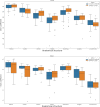Simultaneous lesion and brain segmentation in multiple sclerosis using deep neural networks
- PMID: 33441684
- PMCID: PMC7806997
- DOI: 10.1038/s41598-020-79925-4
Simultaneous lesion and brain segmentation in multiple sclerosis using deep neural networks
Abstract
Segmentation of white matter lesions and deep grey matter structures is an important task in the quantification of magnetic resonance imaging in multiple sclerosis. In this paper we explore segmentation solutions based on convolutional neural networks (CNNs) for providing fast, reliable segmentations of lesions and grey-matter structures in multi-modal MR imaging, and the performance of these methods when applied to out-of-centre data. We trained two state-of-the-art fully convolutional CNN architectures on the 2016 MSSEG training dataset, which was annotated by seven independent human raters: a reference implementation of a 3D Unet, and a more recently proposed 3D-to-2D architecture (DeepSCAN). We then retrained those methods on a larger dataset from a single centre, with and without labels for other brain structures. We quantified changes in performance owing to dataset shift, and changes in performance by adding the additional brain-structure labels. We also compared performance with freely available reference methods. Both fully-convolutional CNN methods substantially outperform other approaches in the literature when trained and evaluated in cross-validation on the MSSEG dataset, showing agreement with human raters in the range of human inter-rater variability. Both architectures showed drops in performance when trained on single-centre data and tested on the MSSEG dataset. When trained with the addition of weak anatomical labels derived from Freesurfer, the performance of the 3D Unet degraded, while the performance of the DeepSCAN net improved. Overall, the DeepSCAN network predicting both lesion and anatomical labels was the best-performing network examined.
Conflict of interest statement
Richard McKinley, Rik Wepfer, Fabian Aschwanden, Lorenz Grunder, Raphaela Muri, Christian Rummel, Rajeev Verma, Christian Weisstanner, Mauricio Reyes, Franca Wagner and Roland Wiest have no interests to declare. Anke Salmen has recieved speaker honoraria and/or travel compensation for activities with Almirall Hermal GmbH, Biogen, Merck, Novartis, Roche, and Sanofi Genzyme, none related to this work. Andrew Chan received honoraria for board and speaker honoraria from Actelion, Bayer, Biogen, Celgene, Merck, Novartis, Sanofi-Genzyme, Roche, Teva, all for hospital/university research funds. He has recieved reserach funds from Research funds: UCB, Biogen, Sanofi-Genzyme, and is an editor for European Journal of Neurology, and Clin Transl Neurosci.
Figures




Similar articles
-
Infratentorial lesions in multiple sclerosis patients: intra- and inter-rater variability in comparison to a fully automated segmentation using 3D convolutional neural networks.Eur Radiol. 2022 Apr;32(4):2798-2809. doi: 10.1007/s00330-021-08329-3. Epub 2021 Oct 13. Eur Radiol. 2022. PMID: 34643779
-
Fully automated longitudinal segmentation of new or enlarged multiple sclerosis lesions using 3D convolutional neural networks.Neuroimage Clin. 2020;28:102445. doi: 10.1016/j.nicl.2020.102445. Epub 2020 Sep 24. Neuroimage Clin. 2020. PMID: 33038667 Free PMC article.
-
Multi-branch convolutional neural network for multiple sclerosis lesion segmentation.Neuroimage. 2019 Aug 1;196:1-15. doi: 10.1016/j.neuroimage.2019.03.068. Epub 2019 Apr 3. Neuroimage. 2019. PMID: 30953833
-
Deep convolutional neural networks for brain image analysis on magnetic resonance imaging: a review.Artif Intell Med. 2019 Apr;95:64-81. doi: 10.1016/j.artmed.2018.08.008. Epub 2018 Sep 6. Artif Intell Med. 2019. PMID: 30195984 Review.
-
3D fully convolutional networks for subcortical segmentation in MRI: A large-scale study.Neuroimage. 2018 Apr 15;170:456-470. doi: 10.1016/j.neuroimage.2017.04.039. Epub 2017 Apr 24. Neuroimage. 2018. PMID: 28450139 Review.
Cited by
-
Emerging deep learning techniques using magnetic resonance imaging data applied in multiple sclerosis and clinical isolated syndrome patients (Review).Exp Ther Med. 2021 Oct;22(4):1149. doi: 10.3892/etm.2021.10583. Epub 2021 Aug 9. Exp Ther Med. 2021. PMID: 34504594 Free PMC article. Review.
-
Assessment of Artificial Intelligence Automatic Multiple Sclerosis Lesion Delineation Tool for Clinical Use.Clin Neuroradiol. 2022 Sep;32(3):643-653. doi: 10.1007/s00062-021-01089-z. Epub 2021 Sep 20. Clin Neuroradiol. 2022. PMID: 34542644 Free PMC article.
-
ALL-Net: Anatomical information lesion-wise loss function integrated into neural network for multiple sclerosis lesion segmentation.Neuroimage Clin. 2021;32:102854. doi: 10.1016/j.nicl.2021.102854. Epub 2021 Oct 12. Neuroimage Clin. 2021. PMID: 34666289 Free PMC article.
-
icobrain ms 5.1: Combining unsupervised and supervised approaches for improving the detection of multiple sclerosis lesions.Neuroimage Clin. 2021;31:102707. doi: 10.1016/j.nicl.2021.102707. Epub 2021 Jun 4. Neuroimage Clin. 2021. PMID: 34111718 Free PMC article.
-
Automatic detection of lesion load change in Multiple Sclerosis using convolutional neural networks with segmentation confidence.Neuroimage Clin. 2020;25:102104. doi: 10.1016/j.nicl.2019.102104. Epub 2019 Dec 9. Neuroimage Clin. 2020. PMID: 31927500 Free PMC article.
References
-
- McFarland, H. F. et al. Using gadolinium-enhanced magnetic resonance imaging lesions to monitor disease activity in multiple sclerosis. Ann. Neurol.32, 758–766, 10.1002/ana.410320609 (1992). - PubMed
-
- Wattjes MP, et al. Evidence-based guidelines: Magnims consensus guidelines on the use of mri in multiple sclerosis—establishing disease prognosis and monitoring patients. Nat. Rev. Neurol. 2015;11:597–606. - PubMed
-
- McKinley R, et al. et al. Nabla-net: A deep dag-like convolutional architecture for biomedical image segmentation. In: Crimi A, et al.et al., editors. Brainlesion: Glioma, Multiple Sclerosis, Stroke and Traumatic Brain Injuries. Cham: Springer International Publishing; 2016. pp. 119–128.
Publication types
MeSH terms
LinkOut - more resources
Full Text Sources
Other Literature Sources
Medical

